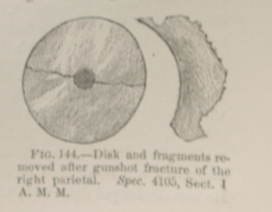Title: Wolf, Joseph
Source text: Surgeon General Joseph K. Barnes, United States Army, The Medical and Surgical History of the War of the Rebellion. (1861–65.), Part 1, Volume 2 (Washington, D.C.: Government Printing Office, 1870), 283-284.
Civil War Washington ID: med.d1e16965
TEI/XML: med.d1e16965.xml
CASE.—Private Joseph Wolf, Co. F, 7th New York Heavy Artillery, aged 22 years, was wounded on April 3d, 1865, before Petersburg, Virginia, by a conoidal ball, which entered the scalp near the posterior superior angle of the right parietal bone, and glanced upward, denuding the bone of periosteum for a space one inch in circumference. He was on the same day admitted to the hospital of the 1st division, Second Corps, and thence conveyed to Washington, where he entered the Armory Square Hospital on the 12th, with complete paralysis of the left arm and leg. He was slightly comatose, but could easily be aroused, and answered questions intelligently; the pupils were contracted. An examination revealed a fissure extending beyond the denuded portion, through which pus slowly exuded, but no depression was observed. Ether was administered on the 14th, and Surgeon D. W. Bliss, U. S. V., applied the trephine. Upon removing the button of bone, a similar fissure through the internal table was discovered. The dura mater protruded through the opening, and upon puncturing the membrane, about three ounces of sero-sanguineous fluid escaped. The operation afforded no immediate relief to the patient, but at the end of six hours he could move his hand and foot, and on the following day could raise his head. On the 20th, the wound was granulating finely, and the patient doing well. He could move his leg and arm freely on the 26th. and was able to stand upon his feet. On May 1st the paralysis had almost disappeared, and the wound was entirely covered with granulations. Two days later a small circle of necrosed bone was removed from the external table. The patient was now able to walk about the ward, and on the 26th, was transferred to the Whitehall Hospital, near Bristol, Pennsylvania, whence he was discharged from the service on June 20th, 1865. His claim for pension was "pending" December 7th, 1871. The specimen is a disk of bone with a serrated fragment of the inner table of the right parietal bone, and is represented in the wood-cut. The disk is one inch in diameter, and is traversed by the line of fracture. The specimen was contributed by the operator, Surgeon D. W. Bliss, U. S. V.
